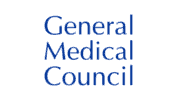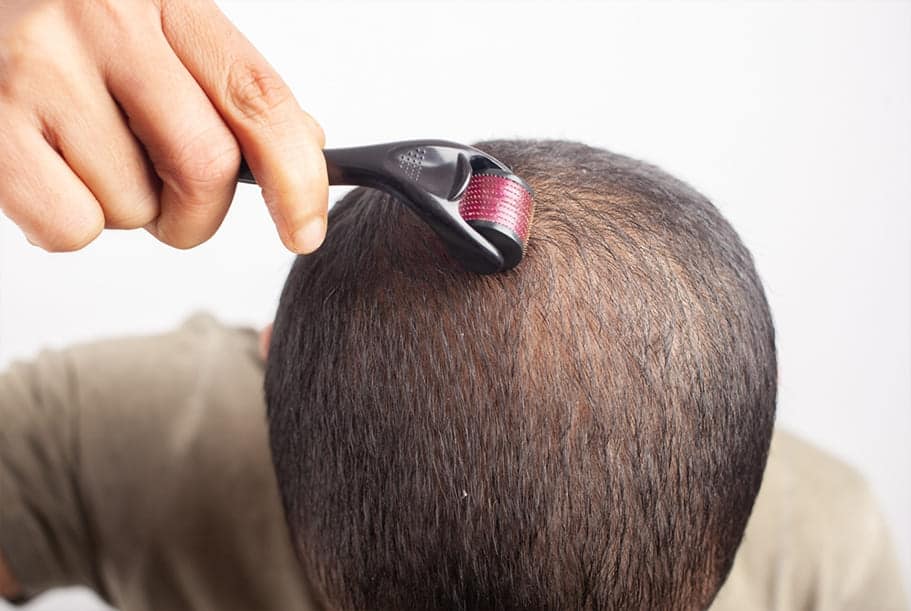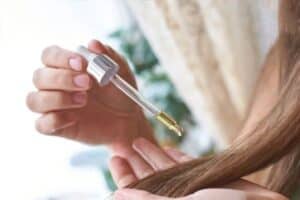So, you’ve probably heard of microneedling for hair loss, but does it actually promote hair growth? On this page, you will find everything you need to know about microneedling, and whether it can stimulate hair growth for conditions such as alopecia areata, male pattern baldness, and female pattern hair loss.
What Is Microneedling For Hair Loss?
Simply put, microneedling is a hair loss treatment that is designed to stimulate new hair growth on the scalp. Using a skin roller, tiny needles help to increase collagen production in the skin.
Microneedling first gained its reputation as a scar treatment during the 1990s. Since then, it’s been studied as a potential alternative or adjuvant treatment for androgenic alopecia and alopecia areata.
When combined with a platelet rich plasma therapy (PRP hair treatment), microneedling for hair loss can be a very effective treatment. This dual treatment can help tremendously with early symptoms of pattern hair loss (male pattern baldness and female pattern baldness).
So, microneedling may be fantastic if you’re looking to improve your scalp health, regrow hair, or combine it with other treatment options or topical medications.
How Does Microneedling For Hair Loss Work?
In short, a microneedling session looks to increase hair growth by stimulating blood flow to the scalp. When doing so, microneedling is effective at treating hair loss and thinning hair. In some cases, it can even promote hair regrowth.
Creating tiny wounds, the micro needles stimulate blood flow on the scalp. This increased blood flow provides oxygen and essential nutrients to your hair follicles, stimulating healthy hair growth.
How Big Are the Needles?
Needle length can often be a factor that puts off many patients from microneedling. However, as the name suggests, microneedling devices use small needles to break/disrupt the top layer of skin.
The needles do not need to be large at all. In fact, they are very similar to a derma roller. As stated above, the aim of a microneedling session is to create micro injuries.
How Effective is Microneedling at Promoting Hair Growth?
Microneedling treatments have been shown to produce encouraging results at stimulating hair growth when combined with other hair loss treatments.
One study, conducted by the International Journal of Thrichology, analysed the combined efficacy of microneedling treatment and minoxidil for hair loss. Results showed a 50% increase in hair regrowth in 80% of participants. So topical minoxidil and scalp microneedling may be effective in treating early cases of androgenetic alopecia.
Whilst microneedling procedures can help to slow down the effects of conditions such as androgenetic alopecia and alopecia areata, they will not be effective in situations where patients suffer with permanent baldness. The only solution in these cases would be an FUE hair transplant.
What Are The Other Benefits of Microneedling?
One of the main benefits of microneedling is that is can also help to increase the uptake of other hair regeneration treatments. By breaking, the top layer of skin, this can increase the absorption rate of the following treatments:
- PRP therapy
- Additional Growth Factors (GFC)
- Minoxidil For Hair Loss
- Azelaic Acid For Hair Loss
So, if you’re considering other hair loss treatments to bolster and thicken your hair follicles, then it may be wise to consider microneedling as well!
What Shall I Expect After My Microneedling Treatment?
Whilst microneedling will certainly help to boost scalp health, it can sometimes be confusing when thinking about side effects. It’s important to differentiate what is supposed to happen with microneedling and what is not!
So, here are the after effects that you can expect to experience for the first couple of days after your treatment:
- bruising
- redness
- oozing from the wounds
- swelling
- pain
Experiencing these symptoms in your microneedling treatment area is very common. In fact, this is actually the aim. Breaking the top dermic layer is needed in order for wound healing and absorption to take place.
What Are The Side Effects of Microneedling?
Generally, side effects are most likely to occur when combining with other treatments. Specifically with Minoxidil use. As minoxidil can sometimes cause irritation and itchiness, microneedling may exacerbate these symptoms.
So, if you think you may be allergic to minoxidil or other hair loss treatments, you should definitely seek professional medical advice before you begin a treatment.
Before any treatment, if you suffer with Eczema, Diabetes, or take blood thinners, then it would definitely be wise to contact your doctor or gp.
So, is Microneedling Worth It?
Microneedling has shown a number of positive results in clinical studies when combined with other hair loss treatments. It has been shown to increase the absorption rate of topical treatments like PRP and Minoxidil.
Whilst microneedling can certainly be effective, it may also be wise to just check with your doctor about having a treatment if you suffer with eczema, diabetes, or take blood thinners.
FAQs
In short yes microneedling can help to regrow hair. It does this by:
- Stimulation of Hair Follicles: Microneedling creates micro-injuries in the scalp, which can trigger the body’s natural wound healing response. This process is believed to stimulate the production of growth factors and cytokines that promote hair follicle health and encourage hair regrowth.
- Improved Blood Circulation: The micro-injuries from microneedling can also lead to increased blood circulation in the scalp. Improved blood flow can provide hair follicles with more nutrients and oxygen, potentially supporting hair growth.
- Enhanced Absorption of Topical Treatments: Microneedling can enhance the absorption of topical treatments, such as minoxidil or topical hair growth products. By creating tiny channels in the scalp, these products may penetrate more effectively, potentially enhancing their effectiveness.
Yes, it is generally safe to use minoxidil after microneedling. Here’s how the two can work together:
- Enhanced Absorption: Microneedling creates tiny channels or micro-injuries in the scalp’s skin. These micro-injuries can improve the absorption and penetration of topical treatments like minoxidil. When applied immediately after microneedling, minoxidil may be more effectively absorbed into the deeper layers of the scalp.
- Synergistic Effects: Microneedling and minoxidil can have complementary effects on hair regrowth. Minoxidil is a vasodilator that promotes blood flow to the hair follicles, while microneedling can also enhance blood circulation in the scalp. Together, they can potentially stimulate hair follicles and promote hair growth more effectively.
The level of pain or discomfort experienced during microneedling can vary from person to person and may depend on several factors, including individual pain tolerance, the depth of the microneedling, and the use of numbing creams.








